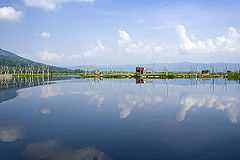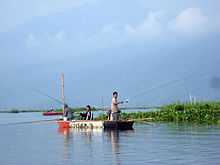Lake Rawa Pening
| Rawa Pening | |
|---|---|
 Rawa Pening in 2008 | |
| Coordinates | 7°17′S 110°26′E / 7.283°S 110.433°ECoordinates: 7°17′S 110°26′E / 7.283°S 110.433°E |
| Basin countries | Indonesia |
| Surface area | 2,500 to 2,670 hectares (25.0 to 26.7 km2; 9.7 to 10.3 sq mi) |
Rawa Pening (literally meaning 'Clear Swamp', from the Javanese Bening) is a lake in the Ambarawa Basin in Central Java, Indonesia. It serves as a source of power, irrigation, and flood control, and is used for fishing. Due partly to high numbers of aquatic plants, it may dry out by 2021.
Location and description
Rawa Pening is located in the volcanic Ambarawa Basin in Central Java, [1] between Ambarawa and Salatiga. It covers a total area of 2,500 to 2,670 hectares (25.0 to 26.7 km2; 9.7 to 10.3 sq mi).[2][3] It is shallow and swamplike,[1] with muddy banks.[4]
History
Rawa Pening is estimated to have been formed between 18,000 and 13,500 BC after a period of increased precipitation. It reached its largest size from 11,000 to 9,000 BC, but shrank until it reached its current size around 6,000 BC.[5]
In order to protect Rawa Pening, the local government has enacted a green belt policy. Several establishments, such as the tourist attraction Kampoeng Rawa, were controversial owing to their construction within this belt.[6]
Role

One of the major roles of Rawa Pening is as a source of hydroelectricity, with a power station located on the Tuntang River near the lake. Fishing is common as a source of supplementary income, and the water from the lake irrigates nearby rice fields. It has also been cited as being used for flood control.[4]
Plant infestation

Numerous species of aquatic plants live in Rawa Pening, including Panicum repens,[7] Eichhornia crassipes, Salvinia cucullata,[8] and Hydrilla verticillata.[3] Estimates of the total number of species vary, from 20 in 1949 to 19 aquatic and 71 semi-aquatic species in 1972.[9] According to Soenarto Hardjosuwarno, P. repens is one of the main contributors to the formation of floating islands in the lake,[7] with M. Soerjani noting that E. crassipes and S. cucullata also contribute.[8] The aquatic plants, such as H. verticillatta, take root in the large amount of peat (in some places measuring 2 metres (6.6 ft) thick), causing more peat to gather. Eventually, terrestrial plants take root in the floating islands as well.[10]
According to Tri Retnaningsih Soeprobowati, a researcher at Diponegoro University in Semarang, Rawa Pening could become dry by 2021 due to increasing sedimentation. She reports a total rate of deposition of 270 to 880 kilograms (600 to 1,940 lb) per day, averaging 780 tonnes yearly,[2] with the water level dropping 29% since 1989.[3] The overabundance of aquatic plants has been blamed, especially E. crassipes. As such, there are calls for a culling of the E. crassipes population to 20% by 2030.[3] Other suggestions include the introduction of grass carp to control the plant population and the use of herbicides as last resorts.[2][3] The destruction of H. verticillatta had earlier been attempted beginning in 1932, originally using mechanical methods but later switching to herbicides. These efforts were discontinued in the 1960s.[11]
References
- Footnotes
- ↑ 1.0 1.1 Sémah et al. 2004, p. 64.
- ↑ 2.0 2.1 2.2 Nugrahanti 2011, Rawa Pening.
- ↑ 3.0 3.1 3.2 3.3 3.4 Nugrahanti 2011, 2030 Rawa Pening.
- ↑ 4.0 4.1 UNEP, Role of Rawa Pening.
- ↑ Sémah et al. 2004, p. 85.
- ↑ Herusansono 2012, Kampoeng Rawa.
- ↑ 7.0 7.1 Siregar & Soemarwoto 1976, p. 211.
- ↑ 8.0 8.1 Soerjani 1976, p. 63.
- ↑ Soerjani 1976, p. 64.
- ↑ Soerjani 1976, pp. 64-65.
- ↑ Soerjani 1976, p. 75.
- Bibliography
- Herusansono, Winarto (20 December 2012). "Kampoeng Rawa Salahi Peruntukkan Rawapening" [Kampoeng Rawa Goes Against Planning for Rawapening]. Kompas (in Indonesian). Archived from the original on 6 July 2014. Retrieved 6 July 2014.
- Nugrahanti, Amanda Putri (3 March 2011). "2030, Rawa Pening Bebas Eceng Gondok" [2030, Rawa Pening must be free of water hyacinths]. Kompas (in Indonesian). Retrieved 1 September 2011.
- Nugrahanti, Amanda Putri (15 March 2011). "Rawa Pening 10 Tahun Lagi Jadi Daratan" [Rawa Pening Could Be Land in 10 Years]. Kompas (in Indonesian). Retrieved 1 September 2011.
- "Role of Rawa Pening". United Nations Environment Programme. Retrieved 1 September 2011.
- Sémah, Anne-Marie; Sémah, François; Moudrikah, Rachid; Fröhlich, François; Djubiantono, Tony (2004). "A Late Pleistocene and Holocene Sedimentary Record in Central Java and its Palaeoclimatic Significance". In Keates, S.G.; Pasveer, Juliette Maria. Quaternary research in Indonesia. Modern quaternary research in Southeast Asia 18. Leiden: A.A.Balkema. pp. 63–88. ISBN 978-90-5809-674-6. OCLC 61693775.
- Siregar, H.; Soemarwoto, Otto (1976). "Studies on Panicum Repens L. in West Java". In Varshney, C. K.; Rzoska, Julian. Aquatic weeds in South East Asia : proceedings of a Regional Seminar on Noxious Aquatic Vegetation, New Delhi, 12-17 December 1973. Hague: W. Junk. pp. 211–214. OCLC 21650665.
- Soerjani, M. (1976). "Aquatic Weed Problems in Indonesia, with Special Reference to the Construction of Man-Made Lakes". In Varshney, C. K.; Rzoska, Julian. Aquatic weeds in South East Asia : proceedings of a Regional Seminar on Noxious Aquatic Vegetation, New Delhi, 12-17 December 1973. Hague: W. Junk. pp. 63–78. OCLC 21650665.